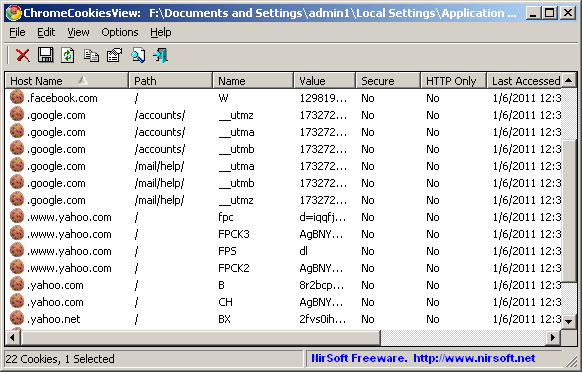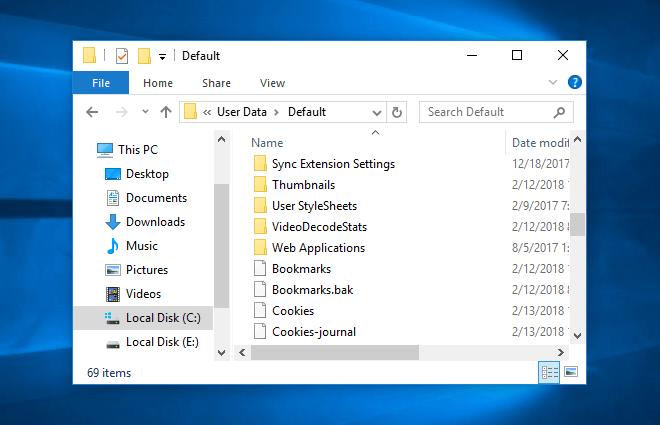If you want to view your browser's cookies on Google Chrome, first, click on the icon of 3 stacked dots, which should be in the top right corner of the window. Then, go to 'Settings' and scroll down to 'Advanced.' Click on 'Content Settings,' then click 'Cookies' and select 'See all cookies and site data' to review your cookies. The method for how to view cookies is listed below. Microsoft Internet Explorer 8.0 - 11.0 Select the 'Tools-Internet Options' menu item, and then click the 'Settings' button under the 'General' tab. Click the 'View Files' button to see a list of the temporary internet files that Explorer has stored.
View Stored Cookies Windows 10 Location
Aug 21, 2019 If you want to view your browser's cookies on Google Chrome, first, click on the icon of 3 stacked dots, which should be in the top right corner of the window. Then, go to 'Settings' and scroll down to 'Advanced.' Click on 'Content Settings,' then click 'Cookies' and select 'See all cookies and site data' to review your cookies. In Internet Explorer, select the Tools button, and then select Internet options. Select the Privacy tab, and then under Settings, move the slider to the top to block all cookies or the bottom to allow all cookies. From IE10 and up, only the cookie itself is stored in the roaming directory and the instructions of what site they belong to and how they're to be used are stored in a database located at%userprofile%AppDataLocalMicrosoftWindowsWebCacheWebCacheV01.dat.
View Stored Cookies Windows 10 Download
Let's say I set a cookie using the setcookie() function in PHP:
I can see it in:
However, I can not find the actual file stored on my hard disk. Can anyone tell me where this specific cookie is stored on the hard disk?
6 Answers
Apologies, the answer is due to the fact that Google Chrome uses an SQLite file to save cookies. It resides under:
inside Cookies file. (which is an SQLite database file)
So it's not a file stored on hard drive but a row in an SQLite database file which can be read by a third party program such as: SQLite Database Browser
EDIT: Thanks to @Chexpir, it is also good to know that the values are stored encrypted.
varDumper varDumper
varDumperFor Google chrome Version 56.0.2924.87 (Latest Release) cookies are found inside profile1 folder.
If you browse that you can find variety of information.
There is a separate file called 'Cookies'. Also the Cache folder is inside this folder.
Path :C:Usersuser_nameAppDataLocalGoogleChromeUser DataProfile 1
Remember to replace user_name.
For Version 61.0.3163.100
Path :C:Usersuser_nameAppDataLocalGoogleChromeUser DataDefault
Inside this folder there is Cookies file and Cache folder.
SridharanSridharanC:Users<current_user>AppDataLocalGoogleChromeUser Data<Profile 1>Cookies(Type:File)

Chrome doesn't store each cookies in separate text file. It stores all of the cookies together in a single file in the profile folder. That file is not readable.
Since the expiration time is zero (the third argument, the first false) the cookie is a session cookie, which will expire when the current session ends. (See the setcookie reference).
Therefore it doesn't need to be saved.
Some programmer dudeSome programmer dudeActually the current browsing path to the Chrome cookies in the address bar is:chrome://settings/content/cookies
Not the answer you're looking for? Browse other questions tagged google-chromecookies or ask your own question.
Deleting the temporary files is one of the best ways out there to free up some significant amount of free space on your Windows operating system.
Long time Windows users likely know how to manually delete temporary files without the help of third-party PC cleaning utilities like CCleaner.
There is an easy and safe method to delete temporary files in Windows 10. You can use the Settings app to safely clear all temporary files in Windows 10 without installing additional software. Here is how to use the Settings app to safely delete temporary files in Windows 10.
Deleting temporary files in Windows 10
Step 1: Open Settings app by clicking its icon in the left-pane of the Start menu.
Step 2: At the home page of Settings app, click on System icon.
Step 3: Click Storage. Under Storage section, click on the drive where Windows 10 is installed. For convenience, on the Settings page, Windows 10 displays Windows logo on the drive where Windows 10 is installed.

Step 4: Once you click on the system drive (where Windows 10 is installed), you will see the Storage usage page. The page displays the disk space used by system and reserved files, apps & games, documents, pictures, music, videos, mail, desktop, other users, maps, OneDrive, and temporary files.
Step 5: As you can see in the picture below, just below the Temporary files entry, Windows 10 displays the space used by temporary files. On my PC, temporary files are using a whopping on 11.5 GB. Note that Windows 10 takes in to account of space used by Downloads folder, Recycle Bin, previous version of Windows (Windows.old folder), and temporary files folder while calculating the size of temporary files.
Click on Temporary files.
Step 6: Next, at the Temporary files page, select the check box next to Temporary files and then Remove files button to delete all temporary files from your Windows 10 PC. If you see the confirmation dialog, click Yes or OK button to begin deleting files.
The traditional way of manually cleaning temporary files
Step 1: Open the Run command box by simultaneously pressing Windows logo and R keys.
Step 2: Type %temp% and then press Enter key to open the Temp folder containing temporary files.
Step 3: Select all files and folders and then click the Delete key to delete all temporary files. It’s a good idea to move temporary files to the Recycle Bin and permanently delete them after a few days so that if a program or Windows doesn’t work properly after deleting temporary files, you can restore them.